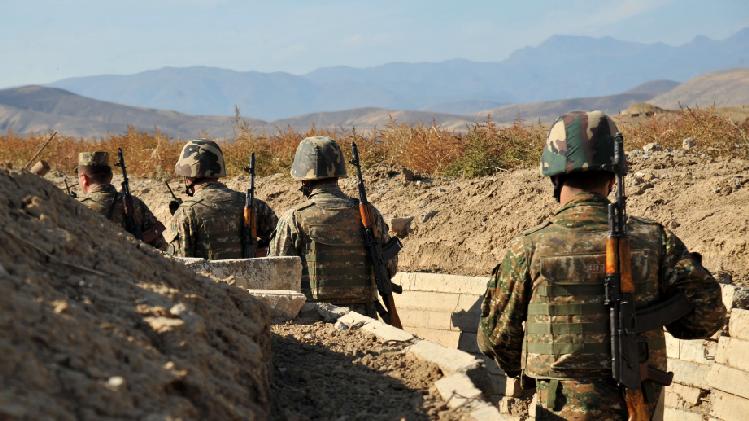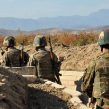
Tensions Continue Along Line of Contact Around Karabakh
Publication: Eurasia Daily Monitor Volume: 12 Issue: 17
By:

On January 2–3, clashes took place along the Line of Contact between Azerbaijan and the unrecognized, Armenian-backed Nagorno-Karabakh Republic (NKR), resulting in casualties on both sides. Though a cease-fire between Armenia and Azerbaijan was reached in 1994, it has regularly been violated for more than 20 years. The violation of the ceasefire regime and the loss of two Armenian soldiers provoked public outrage in Armenia, which was, to some extent, incited by the fact that the incident took place shortly after the New Year holiday. On January 3, the Ministry of Foreign Affairs of Armenia lashed out at the Azerbaijani Armed Forces, accusing Azerbaijan’s military of acting in “flagrant contempt toward the appeals of the OSCE [Organization for Security and Cooperation in Europe] Minsk Group Co-Chair Countries to refrain from provocative actions and escalation of the situation during religious holidays” (Mfa.am, January 3).
Simultaneously, the Armenian Ministry of Defense made a similar statement, asserting that any provocation, supported by the Azerbaijani authorities in 2015, would be punished, thereby attributing the responsibility for the casualties to the Azerbaijani authorities (Mil.am, January 3). The statements, made by the two ministries shortly after the incident, were an attempt to draw international attention to the still unresolved but periodically violent Karabakh conflict.
Nevertheless, new tensions arose during the following days. On the night of January 3–4, alone, the ceasefire regime was violated nearly 300 times; meanwhile on January 4–5, there were about 350 ceasefire violations (Civilnet.am, January 4). Tensions escalated further on January 5–6, resulting in new casualties. According to current data released by the Defense Army of the self-declared NKR, over the course of that night, the ceasefire was violated 320 times (News.am, January 6).
The new developments prompted a string of condemnations from international officials, including Jen Psaki, the Spokesperson for the US Department of State, James Warlick, the United States’ Co-Chair of the OSCE Minsk Group, as well as Luis Almagro, the minister of foreign affairs of Uruguay (Tert.am, Yerkirmedia.am, Armnewstv.am, January 6).
Nevertheless, violence along the Line of Contact continued unabated over the following days. The Armenian website Tert.am reported that on January 11, an 80-year-old villager was killed by Azerbaijani military forces near the village of Baghanis, close to the Armenian-Azerbaijani border (Tert.am, January 12). The situation became more critical on January 19–21 when another two Armenian soldiers were killed. Notably, these shootings took place just after Armenia was rocked by the shocking murder of seven Armenians by a Russian soldier from the 102nd military base in Gyumri (see EDM, January 16). Allegedly, following the February 2008 Armenian presidential elections, which provoked strong clashes between the authorities and the opposition, Azerbaijan tried to create a similarly tense border situation in March, thereby sharpening the political situation in Yerevan (Tert.am, January 20, 2015). In other words, every instance of wide-scale domestic turmoil inside Armenia appears to be accompanied by renewed unrest along the Armenian-Azerbaijani border.
The latest clashes near Karabakh and the Armenian-Azerbaijani border were remarkable from both a military and a political perspective. In terms of the military dimension, Azerbaijan started using grenade launchers and other new weapons, which had not been employed in the border areas since the ceasefire (Azatutyun.am, January 20). Similarly, the downing of an Armenian Mi-24 helicopter in November 2014 was the first case of military activity being carried out in the airspace over Karabakh since 1994 (Apa,az, January 27, 2015; RFE/RL, January 28; CACI Analyst, December 10, 2014). Evidently, Azerbaijan is applying new tactics and weapons to the conflict, which places new challenges on the Armenian defense system and may ultimately have a destabilizing effect on the wider region. And on a strategic level, continued escalatory clashes are forcing both sides in the conflict to repeatedly re-assess the regional military balance and further intensify their 20-year-long arms race.
As for the political implications, the multiple ceasefire violations at the beginning of the new year are undoubtedly a bad signal for the Karabakh peace process in 2015. Naturally, the loss of dozens of soldiers bolsters skepticism over the current OSCE negotiations format, which is, in fact, the only open channel of communication between high-level officials of Armenia and Azerbaijan. Despite the fact that three meetings took place between Armenian and Azerbaijani presidents in the second half of 2014, the current situation undermines the possibility for further OSCE-brokered bilateral talks in the near future. Thereby, Armenian authorities realize that it will be impossible to reach any consensus with their neighboring state in the near term, and Azerbaijani military and foreign policy looks likely to remain unchanged this year.




